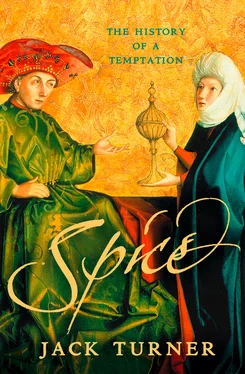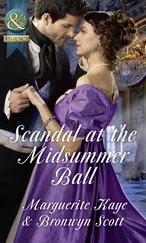Historically, of course, neither chemistry nor the curiosities of natural selection could be known, and there were other qualities that marked out a spice. Before the European discovery of the Americas the rare and fine spices were, practically by definition, Asian. There was no shortage of other, home-grown aromatics native to the Mediterranean basin, among them many spices now widely associated with Eastern cuisine, such as coriander, cumin and saffron. (In medieval times England was a major producer of saffron – a reminder that traffic along the spice routes went both ways.) Moreover, many substances formerly counted as spices are today classed otherwise. Early in the fourteenth century the Florentine merchant Francesco Balduccio Pegolotti wrote a business guide in which he listed no fewer than 188 spices, among them almonds, oranges, sugar and camphor. When Lady Capulet calls for spices Juliet’s nurse takes her to mean dates and quinces. Generally, however, the spices were alike in being small, long-lasting, high-value and hard to acquire. Above all, the word conveyed a sense of their uniqueness; there was no substitute. To say a spice was special was tautological; indeed the words have a common root. And as a sense of their exceptionalism was embedded in their name so it was integral to their appeal.
By any measure the most exceptional of the spices, and far and away the most historically significant, is pepper. The spice is the fruit of Piper nigrum, a perennial climbing vine native to India’s Malabar Coast. Its tendrils bear clusters of peppercorns on dense, slender spikes, turning a yellowish-red at maturity, like redcurrants. On this one plant grow the three true peppers: black, white and green. Black pepper, the most popular variety, is picked while still unripe, briefly immersed in boiling water, then left to dry in the sun. Within a few days the skin shrivels and blackens, giving the spice its distinctive wrinkly appearance. White pepper is the same fruit left longer on the vine. After harvest the outer husk is softened by soaking, left to dry and rubbed off in water or by mechanical action. Green or pickled peppercorns are picked while still unripe, like black pepper, then immediately soaked in brine.
Pepper has several lookalikes, the cause of much confusion, which all belong to different species. Melegueta pepper was widely used in medieval times, but is now confined to speciality shops, a fate shared by long pepper. (The latter is doubly confusing for sharing an Indian origin with black pepper, whereas Melegueta pepper is native to Africa.) The attractive pink peppercorns commonly sold in combination with the other peppers are entirely unrelated – the plant, native to South America, is in fact mildly toxic, recommended more by its appearance than its taste.
The clove, on the other hand, is unmistakable. The spice is the dried, unripe flower bud of Syzygium aromaticum, * an evergreen tree reaching a height of twenty-five to forty feet (eight to twelve metres), thickly clothed with glossy, powerfully aromatic leaves. A walk through the perfumed groves of Zanzibar or the Indonesian islands is an unforgettable experience; in the age of sail mariners claimed they could smell the islands while still far out to sea. The clove itself grows in clusters coloured green through yellow, pink and finally a deep, russet red. Timing, as with pepper, is everything, since the buds must be harvested before they overripen. For a few busy days of harvest the more nimble members of the community head to the treetops, beating the cloves from the branches with sticks. As the cloves shower down they are gathered in nets and spread out to dry, hardening and blackening in the tropical sun and taking on the characteristic nail-like appearance that gives the spice its name, from the Latin clavus, nail. The association is common to all major languages. The oldest certain reference to the clove dates from the Chinese Han period (206 BC to AD 220), when the ‘ ting-hiang ’ or ‘nail spice’ was used to freshen courtiers’ breath in meetings with the emperor.
For reasons of both history and geography, the clove is often paired with nutmeg and mace. The latter two are produced by one and the same tree, Myristica fragrans. The tree yields a crop of bulbous, yellowy-orange fruit like an apricot, harvested with the aid of long poles, with which the fruit is dislodged and caught in a basket. As the fruit dries it splits open, revealing a small, spicy nugget within: a glossy brown nutmeg clasped in a vermilion web of mace. Dried in the sun, the mace peels away from the nutmeg, fading from scarlet to a ruddy brown. Meanwhile the aromatic inner nutmeg hardens and fades from glossy chocolate into ashen brown, like a hard, wooden marble. Legend has it that unscrupulous spice traders of Connecticut conned unwitting customers by whittling counterfeit ‘nutmegs’ from worthless pieces of wood, whence the nickname the ‘Nutmeg State’. A ‘wooden nutmeg’ was a metaphor for the fraudulent or ersatz. Schele de Vere’s nineteenth-century Americanisms cites the ‘wooden nutmegs’ of the Press and Congress who ‘have to answer for forged telegrams, political tricks, and falsified election returns’.
Adulteration, conned customers and mistaken identities are recurrent themes in the history of spice, bedevilling the historian’s sources just as they did, historically, the consumers. The problems were particularly acute with cinnamon – a fact, we shall see, with some considerable ramifications, and over which scholars continue to wage arcane debates to this day. The tree that bears the spice, Cinnamomum zeylanicum, is a small, unassuming evergreen, resembling a bay or laurel, native to the wet zone of Sri Lanka, in the island’s west and south-west. The spice is formed from the inner bark, which is stripped from the tree with knives, cut into segments and left in the sun to dry, curling into delicate, papery quills. Cinnamon’s best-known relative is cassia, the bark of Cinnamomum cassia, originally a native of China but in historical times widespread throughout South-East Asia. This and several other members of the family were long considered the poor relations – cassia has a coarser, ruddy bark, with a more pungent aroma. (It is also easier and cheaper to produce: much of the ‘cinnamon’ sold in the modern West is in fact cassia.) It is disconcerting, though hardly surprising, to find the medieval consumer more attuned to the difference.
For even the most indifferent there can be no mistaking the last major spice, ginger. Zingiber officinale has been cultivated for so long that it is no longer found in a wild state. Of all the spices it is by far the least fussy, and far the easiest to transplant. The plant will no longer go to seed of its own accord but must be propagated manually, with root-stalk cuttings. (During long oceanic voyages Chinese navigators grew the spice in boxes to ward off scurvy.) Provided the ambient soil and air are sufficiently hot and wet, the slender, reedy stems soon sprout, flowering in dense spikes coloured pale green, before maturing through purple and yellow. The spice is the root, or tuberous rhizome. But, amenable as it is to transplantation, before the technology of refrigeration, air travel and greenhouse, no European had eaten fresh ginger, at least not in Europe. The spice arrived after a long journey by ship and caravan, occasionally candied in syrup but more commonly and conveniently in dried form, either powdered or whole, in the distinctive, gnarly lumps still occasionally to be seen in a Chinese grocery.
These, the archetypal, tropical Asian spices, are the main subjects of this book – the dramatis personae. Occasionally the narrative strays beyond them, for as we have seen, ‘spice’ was never a clear-cut category. There were others that rose into and fell from favour, however these were foremost, whether on grounds of cost, origin, reputation or the sheer longevity and intensity of demand. They were in a class of their own. But while spices are the immediate subject, in a broader sense the book is necessarily about Europe and Asia, the appetites that attracted and the links that bound. For the most part, however, the scene and action of the following chapters are written from a European perspective, partly on account of my own linguistic limitations, but also in deference to what might be termed the law of increasing exoticism. A fur coat is standard in Moscow, a luxury in Miami. When the world was an immeasurably larger place so it was with spices, and particularly these spices. The further they travelled from their origins the more interesting they became, the greater the passions they aroused, the higher their value, the more outlandish the properties credited to them. What was special in Asia was astonishing in Europe. In the European imagination there never was, and perhaps never will be again, anything quite like them.
Читать дальше











